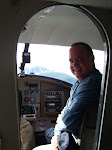 My wife is out of town this weekend. Our daughter has an event at college, and Alice wanted to attend. So, can I find something to do with myself? Yep, I'll go flying, and what a beautiful day it was. I took off a little after 8:00 with no sign of clouds in the sky, calm winds, cool temperatures and great visibility. Typical November day in Florida.
My wife is out of town this weekend. Our daughter has an event at college, and Alice wanted to attend. So, can I find something to do with myself? Yep, I'll go flying, and what a beautiful day it was. I took off a little after 8:00 with no sign of clouds in the sky, calm winds, cool temperatures and great visibility. Typical November day in Florida.I set out to practice all my practical test maneuvers and all the landing/take off procedures. I accomplished nearly all, with varying degrees of success. The maneuvers went very well. I caught my own wake in the steep turn to the right. Transitioned to slow flight while keeping my heading and altitude. Rode the ragged edge of the stall for a minute and went back to normal cruise. I know I'm getting more comfortable in the plane by myself. I did the dreaded power-on stall without Rob. Kept my heading, recovered and had no problems. The only minor problem was that I would have over shot my landing site when I practiced an emergency landing. I'll have to do a few more of those to better judge my glide path. The winds were so light, there was little point in practicing turns around a point.
I headed back to Whitted. My landings were good, but not great. Actually, I was very happy with the way I handled my most serious error. Coming back from the beach, I must not have been paying attention. I found my self too high and way too fast on final. I immediately decided to go around. I had worried that I tend to fixate on the landing, and have not actually needed to go around to this point. When the need arouse, I did the right thing. I practiced all my landing and take off techniques. The biggest problem I'm having is switching gears from one technique to another. I'll have to do all of them when my check ride comes, so I'll just keep working on it.
Alice took the good camera with her, so the shot at the top is from my cell phone. There are a lot of interesting aircraft at Whitted on the weekends, and I'll get some photos my next opportunity. A WWII vintage Stearman biplane was taxiing out as I was doing my pre-flite, and a Waco cabin biplane was doing sightseeing tours. Both are beautiful airplanes.
You'll need google earth to open and view the lesson 13 file. While not really a lesson, I'll keep the files sequential to avoid confusing myself.
Statistics
Dual Instruction Time: 13 Hours
Solo/PIC Time: 4.1 Hours
Landing: 74






2 comments:
Don't you just love the unblinking eye of GPS, allowing every knucklehead on the Internet to see exactly how you flew?
Your base legs are consistently wider than your crosswind legs because your downwind doesn't parallel the runway. Is that a local procedure, for noise abatement perhaps?
Your crosswind legs are a nice right angle to the runway...I don't know how you do that. I've got buildings and trees to look at...you've just got water with land in the distance!
No, no local procedure for noise abatement. My CFI is paranoid about getting too close to the runway during downwind. He always had me roll out onto downwind a little early. So, I just got into the habit of lining up with a certain building out on the beach. I'm sure it's more parallel when I'm using 18/36. There's nothing but water to look at when in the pattern on that one.
Post a Comment